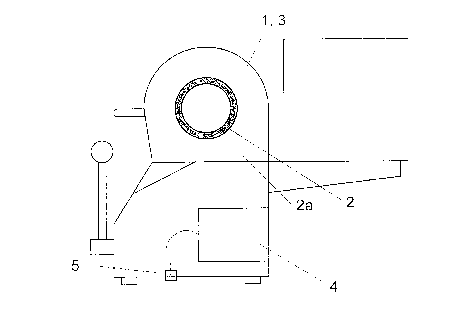Une partie des informations de ce site Web a été fournie par des sources externes. Le gouvernement du Canada n'assume aucune responsabilité concernant la précision, l'actualité ou la fiabilité des informations fournies par les sources externes. Les utilisateurs qui désirent employer cette information devraient consulter directement la source des informations. Le contenu fourni par les sources externes n'est pas assujetti aux exigences sur les langues officielles, la protection des renseignements personnels et l'accessibilité.
L'apparition de différences dans le texte et l'image des Revendications et de l'Abrégé dépend du moment auquel le document est publié. Les textes des Revendications et de l'Abrégé sont affichés :
| (12) Demande de brevet: | (11) CA 2243000 |
|---|---|
| (54) Titre français: | APPAREIL DE SOUDAGE BOUT A BOUT D'ARTICLES EN MATERIAU THERMOPLASTIQUE |
| (54) Titre anglais: | AN APPARATUS FOR BUTT WELDING OF ARTICLES MADE OF THERMOPLASTIC MATERIAL |
| Statut: | Réputée abandonnée et au-delà du délai pour le rétablissement - en attente de la réponse à l’avis de communication rejetée |
| (51) Classification internationale des brevets (CIB): |
|
|---|---|
| (72) Inventeurs : |
|
| (73) Titulaires : |
|
| (71) Demandeurs : |
|
| (74) Agent: | OYEN WIGGS GREEN & MUTALA LLP |
| (74) Co-agent: | |
| (45) Délivré: | |
| (22) Date de dépôt: | 1998-07-14 |
| (41) Mise à la disponibilité du public: | 1999-03-01 |
| Requête d'examen: | 1998-09-25 |
| Licence disponible: | S.O. |
| Cédé au domaine public: | S.O. |
| (25) Langue des documents déposés: | Anglais |
| Traité de coopération en matière de brevets (PCT): | Non |
|---|
| (30) Données de priorité de la demande: | ||||||
|---|---|---|---|---|---|---|
|
Cette invention concerne un appareil et une méthode de soudage bout à bout d'articles en matériau thermoplastique. Ces articles sont maintenus en parfait alignement coaxial par une paire de mécanismes de serrage . Un élément chauffant est placé entre les deux articles pour en chauffer les faces contiguës à une température appropriée puis retiré avant d'abouter lesdites faces des articles l'une sur l'autre. Pour déterminer la résistance de la zone de soudage, on tient compte de la température ambiante. A cette fin, un capteur thermique est monté sur l'appareil de soudage tout en étant thermiquement isolé de celui-ci.
The invention proposes an apparatus an a method of welding together articles
made of a thermoplastic material by means of a butt welding method. The articles are
held in coaxial relationship by means of a pair of clamping mechanisms. A heating
element can be brought between the two articles to heat up their respective facing
front faces, whereafter the heating element is removed and the heated front faces
brought into mutual contact. For determining the strength of the welding zone, the
ambient temperature is considered. For this purpose, a thermal sensor is provided
that is arranged at the welding apparatus. The thermal sensor is thermally insulated
against the welding apparatus.
Note : Les revendications sont présentées dans la langue officielle dans laquelle elles ont été soumises.
Note : Les descriptions sont présentées dans la langue officielle dans laquelle elles ont été soumises.

2024-08-01 : Dans le cadre de la transition vers les Brevets de nouvelle génération (BNG), la base de données sur les brevets canadiens (BDBC) contient désormais un Historique d'événement plus détaillé, qui reproduit le Journal des événements de notre nouvelle solution interne.
Veuillez noter que les événements débutant par « Inactive : » se réfèrent à des événements qui ne sont plus utilisés dans notre nouvelle solution interne.
Pour une meilleure compréhension de l'état de la demande ou brevet qui figure sur cette page, la rubrique Mise en garde , et les descriptions de Brevet , Historique d'événement , Taxes périodiques et Historique des paiements devraient être consultées.
| Description | Date |
|---|---|
| Inactive : CIB de MCD | 2006-03-12 |
| Inactive : CIB de MCD | 2006-03-12 |
| Demande non rétablie avant l'échéance | 2001-07-16 |
| Le délai pour l'annulation est expiré | 2001-07-16 |
| Réputée abandonnée - omission de répondre à un avis sur les taxes pour le maintien en état | 2000-07-14 |
| Demande publiée (accessible au public) | 1999-03-01 |
| Lettre envoyée | 1998-12-10 |
| Inactive : CIB attribuée | 1998-10-22 |
| Inactive : CIB en 1re position | 1998-10-22 |
| Inactive : CIB attribuée | 1998-10-22 |
| Symbole de classement modifié | 1998-10-20 |
| Exigences pour une requête d'examen - jugée conforme | 1998-09-25 |
| Toutes les exigences pour l'examen - jugée conforme | 1998-09-25 |
| Inactive : Transfert individuel | 1998-09-25 |
| Requête d'examen reçue | 1998-09-25 |
| Inactive : Lettre de courtoisie - Preuve | 1998-09-22 |
| Exigences de dépôt - jugé conforme | 1998-09-17 |
| Inactive : Certificat de dépôt - Sans RE (Anglais) | 1998-09-17 |
| Demande reçue - nationale ordinaire | 1998-09-16 |
| Date d'abandonnement | Raison | Date de rétablissement |
|---|---|---|
| 2000-07-14 |
| Type de taxes | Anniversaire | Échéance | Date payée |
|---|---|---|---|
| Taxe pour le dépôt - générale | 1998-07-14 | ||
| Enregistrement d'un document | 1998-09-25 | ||
| Requête d'examen - générale | 1998-09-25 |
Les titulaires actuels et antérieures au dossier sont affichés en ordre alphabétique.
| Titulaires actuels au dossier |
|---|
| GEORG FISCHER ROHRLEITUNGSSYSTEME AG |
| Titulaires antérieures au dossier |
|---|
| JORG WERMELINGER |